Guide to Different 10 Types of Gloves for Every Industry
Gloves serve many purposes, from protecting hands during work to enhancing performance in sports or completing a fashion look. They come in various styles and materials to meet different needs and situations.
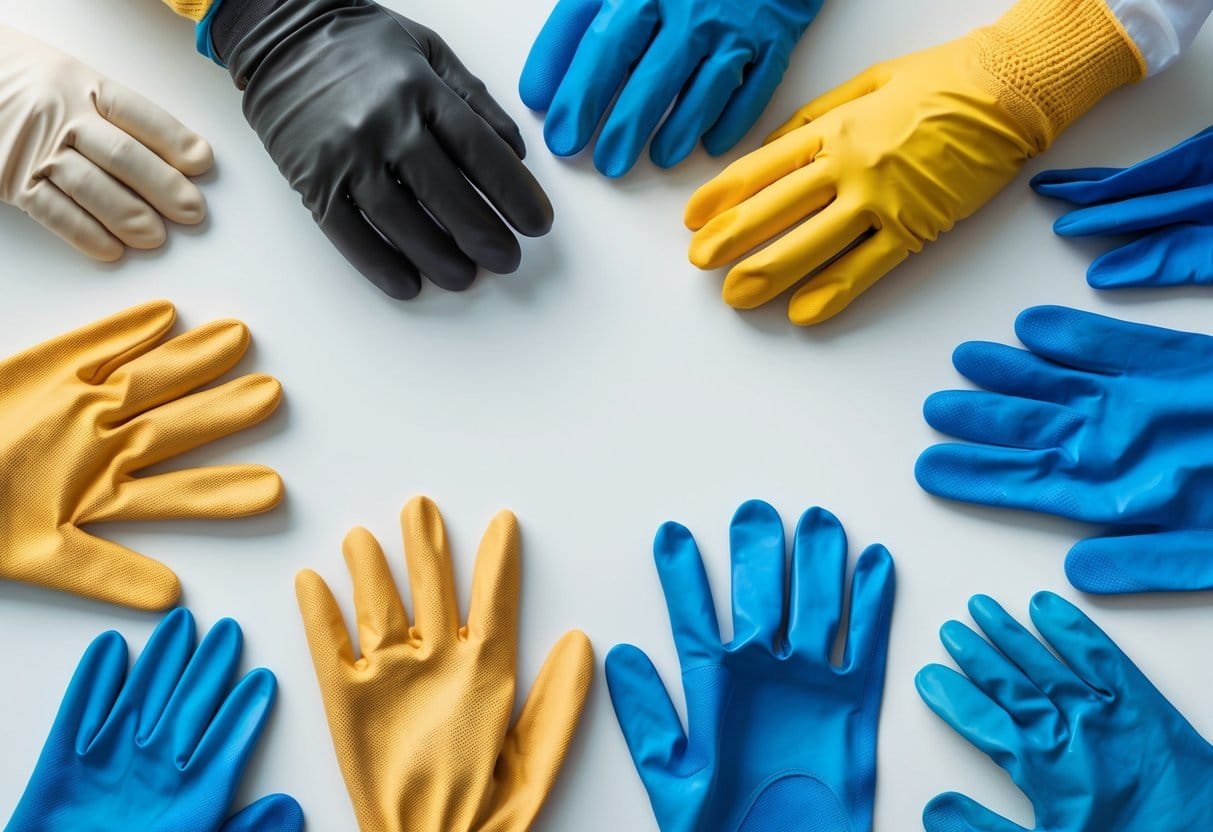
Understanding the types of gloves and their uses helps people pick the right pair for safety, comfort, and function. This guide reviews the main categories of gloves and explains how each type fits specific tasks or occasions
Table of Contents
1) Latex Gloves

Latex gloves are made from natural rubber. They are flexible and fit well, making them popular for tasks that need good hand movement.
They are widely used in healthcare. This is because they protect against many infections and contaminants. Medical workers, lab technicians, and others rely on them for safety.
Latex gloves provide good comfort and sensitivity. This helps when handling small objects or performing precise work. They offer limited protection against sharp objects, so they are not ideal for tasks with high risk of puncture.
Some people are allergic to latex. For those individuals, latex gloves can cause skin reactions. In such cases, other types of gloves are better options.
Latex gloves come in different thicknesses and styles. They can be sterile or non-sterile, depending on the use. Proper selection and use help ensure safety and effectiveness.
2) Nitrile Gloves

Nitrile gloves are made from synthetic rubber. They are a popular alternative to latex gloves because they do not cause allergic reactions. This makes them safer for people with latex allergies.
These gloves offer good resistance to many chemicals and punctures. They are strong and durable, which makes them useful in medical, food, and cleaning industries. Their comfort and fit also help users perform tasks better.
Nitrile gloves come in many types and thicknesses. This variety allows users to choose gloves that match their specific needs, balancing protection and dexterity. They are disposable and should not be washed or reused.
Because nitrile is synthetic, it provides better protection against oils, greases, and some solvents compared to vinyl or latex gloves. This makes nitrile gloves a reliable choice for high-risk jobs involving chemicals or bodily fluids.
3) Vinyl Gloves
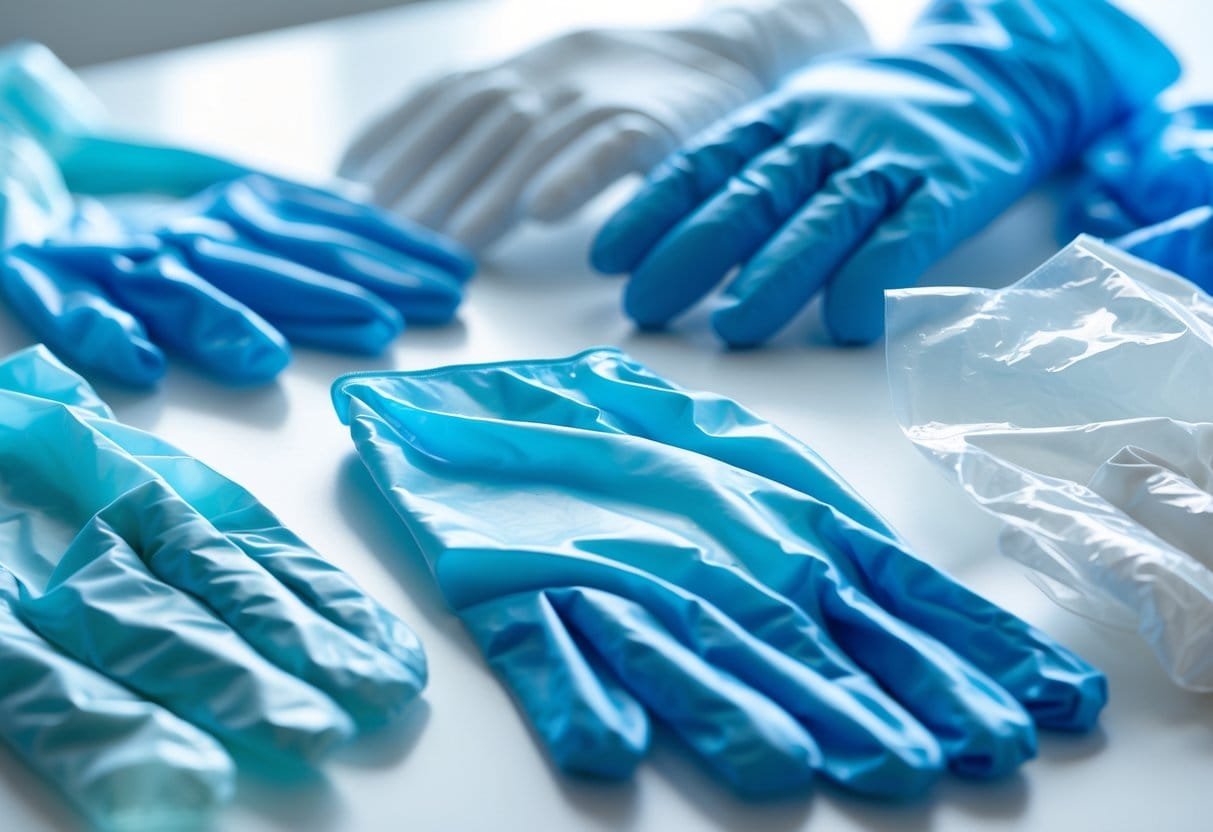
Vinyl gloves are made from a synthetic material called polyvinyl chloride (PVC). They are a popular choice because they are affordable and easy to find. Vinyl gloves are latex-free, which makes them suitable for people with latex allergies.
These gloves provide basic protection and are often used in food handling, cleaning, and light medical tasks. They are not as strong or flexible as nitrile or latex gloves but still offer a good barrier against dirt and some chemicals.
Vinyl gloves come in powder-free versions, which are better for medical and food-related uses since they do not leave residue. They fit more loosely than nitrile or latex gloves, so they are not ideal for tasks that need high sensitivity or precision.
Overall, vinyl gloves are a practical option for low-risk jobs where protection and budget are important. They are not recommended for use with strong chemicals or tasks that require a tight fit.
4) Polythene Gloves

Polythene gloves are made from a type of plastic called polyethylene. They are lightweight and usually designed for short-term use. These gloves provide basic protection against dirt and germs but are not strong enough for heavy-duty tasks.
They come in various styles, including powdered, powder-free, and colored versions. Polythene gloves are often used in food service, cleaning, and other low-risk environments.
These gloves are easy to put on and take off. However, they are less durable than latex or nitrile gloves and can tear more easily. They also do not offer good protection against chemicals or sharp objects.
Because polythene gloves are inexpensive, they are popular where frequent glove changes are needed. They are not suited for medical use or tasks that require high levels of protection.
5) Leather Work Gloves
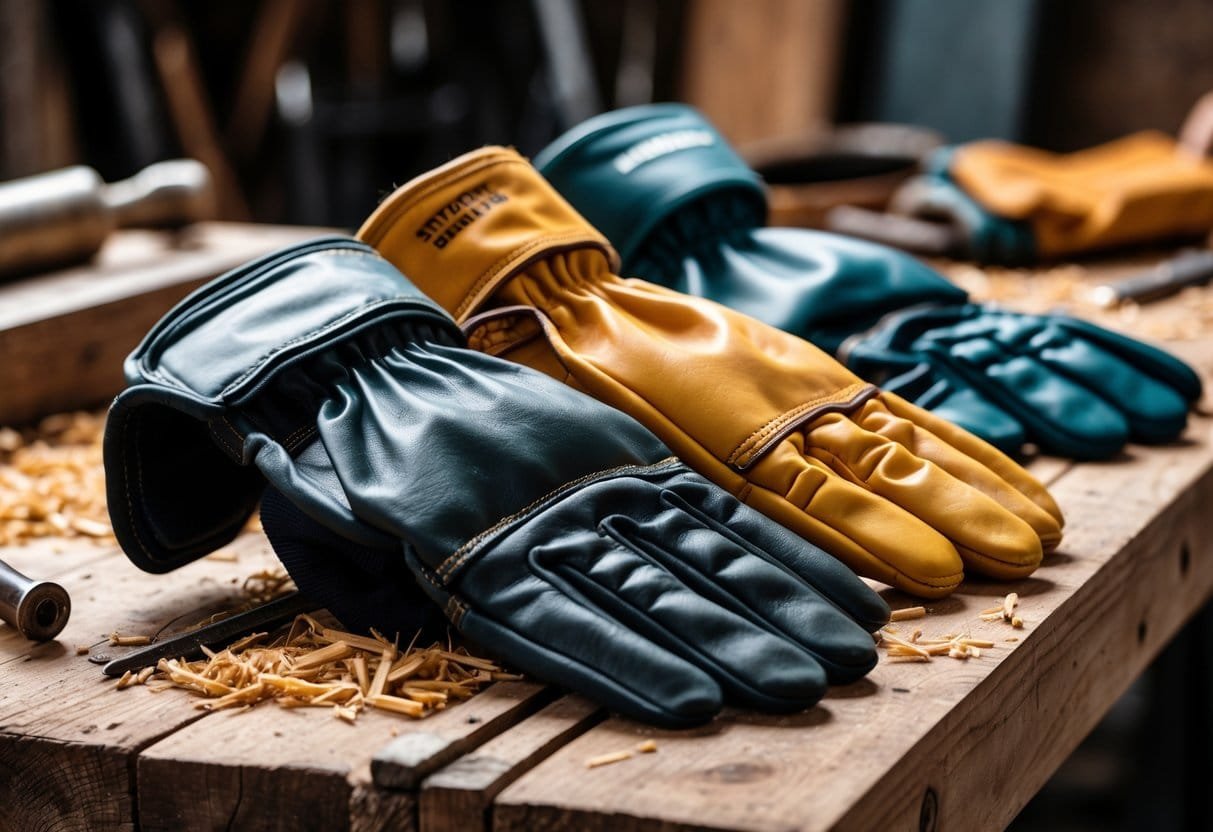
Leather work gloves are popular for their durability and protection. They protect hands from heat, friction, and rough surfaces. This makes them useful for many tasks in construction, farming, and industrial work.
Different types of leather are used for work gloves. Cowhide is the most common because it is tough and lasts a long time. Goatskin offers more flexibility, which helps with hand movement. Pigskin is known for being breathable and resistant to moisture.
Some leather gloves have lining for added warmth in cold weather. Others are unlined for better flexibility. Economy grade leather gloves may have more marks and less durability. These are good for light, temporary jobs.
Overall, leather work gloves are a reliable choice for many jobs that need both protection and comfort. Choosing the right type depends on the work being done and the wearer’s needs.
6) Cut-Resistant Gloves

Cut-resistant gloves protect hands from sharp objects like blades, glass, and metal. They help reduce the risk of cuts and lacerations in jobs involving machinery or sharp tools.
These gloves are made from strong materials such as Kevlar, steel mesh, or high-performance fibers. The materials balance protection, comfort, and flexibility to allow workers to handle tasks safely.
Cut resistance is rated using standards like ANSI/ISEA levels A1 to A9. Higher levels mean greater protection against cuts. Choosing the right level depends on the job’s sharpness risk and required dexterity.
Cut-resistant gloves are important in many industries, including construction, manufacturing, and food processing. They improve safety without too much loss of hand movement or feeling.
Selecting the correct glove means considering the specific work hazards and finding gloves that meet safety standards. This helps keep hands safe while maintaining productivity.
7) Thermal Insulated Gloves

Thermal insulated gloves protect hands from extreme cold and heat. They are designed with materials that trap heat inside, keeping hands warm in low temperatures. These gloves are important for workers in cold environments and for outdoor activities in winter.
The insulation comes from layers of special fabric or synthetic fibers. Some gloves also include waterproof or windproof barriers to improve comfort. Proper sizing is important to ensure warmth and mobility.
Thermal gloves vary in thickness and flexibility. Thicker gloves offer more warmth but less dexterity. Thinner gloves allow better hand movement but may provide less insulation. Choosing the right pair depends on the work or activity being done.
Many thermal gloves meet safety standards for specific industries. This ensures they protect against burns, frostbite, and other thermal injuries. Regular care and maintenance help keep these gloves effective and durable over time.
8) Tactical Gloves
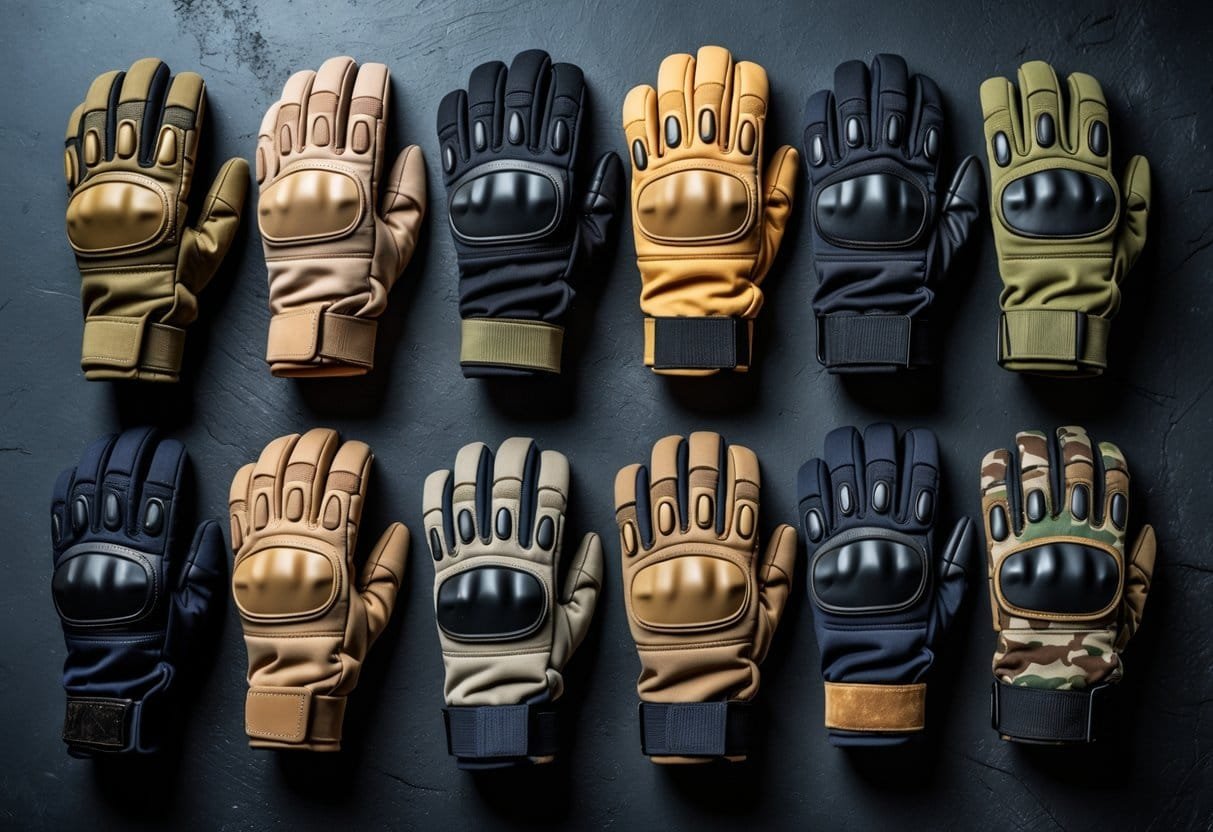
Tactical gloves are designed for use in tough and demanding situations. They provide protection while allowing good hand movement and grip.
There are different types of tactical gloves. Combat gloves often have extra padding and reinforced knuckles for close combat. Shooting gloves are thinner and offer better finger control for precise aiming. Work gloves focus on durability for handling tools and heavy gear.
These gloves are used by military, law enforcement, and outdoor enthusiasts. They protect hands from cuts, impacts, and harsh weather. At the same time, they keep dexterity so users can perform tasks without removing them.
Materials vary, but common choices include leather, synthetic fabrics, and reinforced knuckles or palms. This mix provides protection while keeping gloves flexible.
Maintenance is important to keep tactical gloves effective. Proper cleaning and drying help maintain their grip and protective features.
Tactical gloves balance safety and function. Choosing the right pair depends on the specific activity and environment they will be used in.
9) Sports Gloves
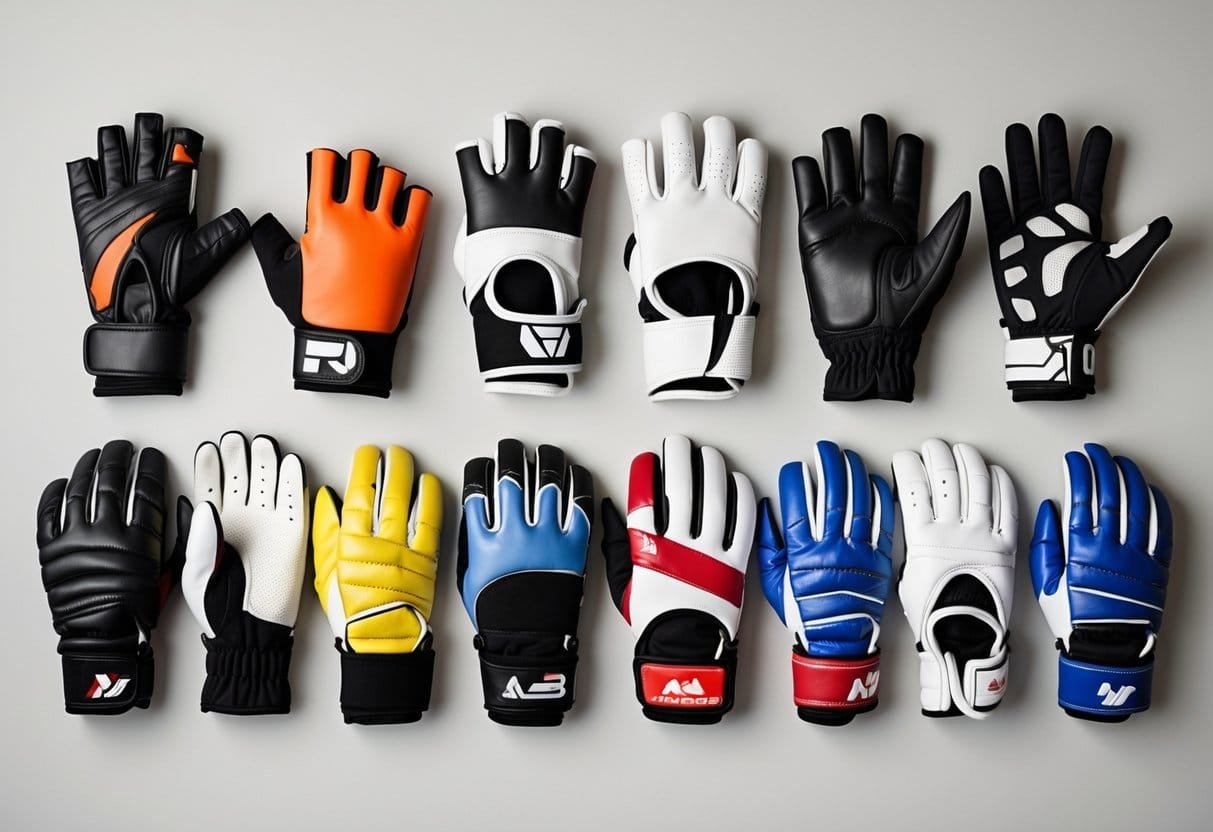
Sports gloves are designed to improve grip, protect hands, and enhance performance in various athletic activities. Different sports require gloves with specific features to meet the demands of the game.
For example, boxing gloves provide padding to protect the knuckles and reduce injury during punches. Cycling gloves often have padded palms to absorb shock and improve grip on the handlebars.
Baseball gloves help players catch and hold the ball more securely. In weightlifting, gloves offer wrist support and prevent calluses from heavy weights.
Sports gloves are usually made from materials like leather, synthetic fabrics, or breathable mesh. These materials help with durability, flexibility, and comfort.
Choosing the right sports gloves depends on the activity and the level of protection needed. Properly fitted gloves can improve safety and performance in any sport.
10) Medical Examination Gloves

Medical examination gloves are designed to protect healthcare workers and patients from infection and contamination. They are made from different materials, including latex, nitrile, and vinyl, each with specific properties suited for various tasks.
Latex gloves offer good elasticity and comfort. They provide high tactile sensitivity, making them ideal for precise procedures. However, some people may have allergies to latex.
Nitrile gloves are synthetic and resistant to many chemicals. They are strong and offer good protection, often used when allergies to latex are a concern. Vinyl gloves are less durable but are a cost-effective option for short tasks with low risk of exposure.
Choosing the right glove depends on the procedure, the user’s needs, and safety standards. Gloves must be durable, fit well, and meet quality requirements to provide proper protection.
Medical gloves play a key role in maintaining hygiene and safety in healthcare settings. Their use helps reduce the risk of infection for both healthcare workers and patients.
Factors to Consider When Choosing Gloves

Choosing the right gloves depends on several important points. The type of material, the purpose they serve, and how well they fit all affect safety and comfort. Each factor helps ensure the gloves do the job correctly and protect the wearer as needed.
Material Selection
The glove’s material must match the task and environment. Common materials include latex, nitrile, vinyl, and leather.
- Latex offers good flexibility and comfort but may cause allergies.
- Nitrile resists chemicals and punctures, making it good for hazardous tasks.
- Vinyl is cheaper and suitable for light use, but less durable.
- Leather is tough and protects well against heat and rough surfaces.
When handling chemicals, nitrile is often best. For medical or food tasks, latex and vinyl work well. The material choice affects durability, shock absorption, and protection level.
Intended Use and Protection Level
Identifying the glove’s primary function is critical. Gloves protect against cold, heat, cuts, chemicals, or germs.
- For cold weather, insulated and waterproof gloves are necessary.
- For chemical handling, materials resistant to specific substances must be selected.
- For sharp tools, gloves with cut resistance reduce injury risk.
Protection requirements vary greatly. The user should consider what hazards they face and how long they need protection. Gloves designed for safety or work tasks often balance protection with flexibility and comfort.
Size and Fit
Gloves must fit properly to function well and remain comfortable. Gloves that are too loose can reduce dexterity. Too tight gloves cause discomfort and reduce blood flow.
Measuring hand size carefully helps pick the correct glove size. Gloves should allow full finger movement and grip without slipping. Some gloves stretch, but the best fit usually comes with precise sizing.
Proper fit improves safety by keeping gloves in place and preserving hand control during tasks. Sizing charts and trying gloves before use help ensure the best fit.
Proper Care and Maintenance of Gloves

Gloves need regular care to stay effective and safe. This includes cleaning them properly, storing them well, and knowing when to replace them. Each of these steps helps protect the user and extends the life of the gloves.
Cleaning Methods
Cleaning gloves depends on their material. For example, latex and rubber gloves should be rinsed with water and mild soap after use. Avoid harsh chemicals that can damage the material.
Cotton gloves can usually be machine washed but check the label for specific instructions. Leather gloves require special cleaners designed for leather to avoid drying and cracking.
After cleaning, gloves should be completely dried before storage. Wet gloves can develop mold or lose their protective qualities.
Storage Practices
Gloves should be stored in a cool, dry place away from direct sunlight. Heat and light can weaken materials like latex and rubber over time.
It’s best to keep gloves flat or loosely folded, avoiding sharp bends that cause cracks or tears. Use a sealed container or drawer to protect them from dust and chemicals.
For gloves used with chemicals, store them separately to prevent contamination. Proper storage helps gloves maintain flexibility and strength.
When to Replace Gloves
Gloves must be replaced when they show signs of damage such as holes, tears, or thinning areas. Even small damage can reduce protection.
If gloves become stiff, cracked, or sticky, they no longer provide safe use. Also, gloves used for chemical or infectious materials should be replaced after each use.
Frequent inspection is key. Workers should check gloves before and after use to catch problems early and avoid injuries.
Frequently Asked Questions
Gloves come in many materials and designs to suit different tasks and industries. Choosing the right glove depends on understanding their features, uses, and safety levels.
What are the primary materials used in the manufacturing of gloves?
The main materials include latex, nitrile, vinyl, polythene, and leather. Latex is natural rubber, flexible and biodegradable. Nitrile is synthetic, resistant to chemicals and punctures. Vinyl is less elastic and cheaper. Polythene is lightweight and disposable. Leather is durable and used mostly for heavy work.
How do different gloves cater to various industries, especially medical and fashion?
Medical gloves, often latex or nitrile, meet strict safety standards to protect against germs. Fashion gloves focus on style, material, and comfort rather than protection. Work gloves like leather offer durability while sporting gloves provide grip and flexibility.
Can you explain the classification system for protective glove levels?
Protective gloves are classified by their resistance to hazards like chemicals, cuts, heat, or electrical risks. Each type must meet specific industry standards. For example, medical gloves pass tests for barrier integrity, while work gloves might be rated for cut resistance.
What are the key differences between single-use disposable gloves and reusable gloves?
Disposable gloves, such as latex, nitrile, vinyl, and polythene, are meant for limited use to prevent contamination. Reusable gloves, like leather or heavy-duty work gloves, are designed for extended wear and tougher conditions. Reusable gloves often offer better protection but need proper maintenance.
What factors should be considered when selecting gloves for workplace safety?
Important factors include the type of hazard, glove material, fit, comfort, and required safety standards. Chemical exposure calls for nitrile or specialized gloves. For physical work, thickness and durability are key. Proper sizing ensures effectiveness and reduces hand fatigue.
How many types and subtypes of gloves exist, and what are their specific applications?
There are over a dozen types, including latex, nitrile, vinyl, polythene, leather, fleece, and specialized tactical gloves. Each serves different purposes like medical use, industrial safety, weather protection, sports, or fashion. Subtypes vary by material thickness, grip, and resistance to hazards.







